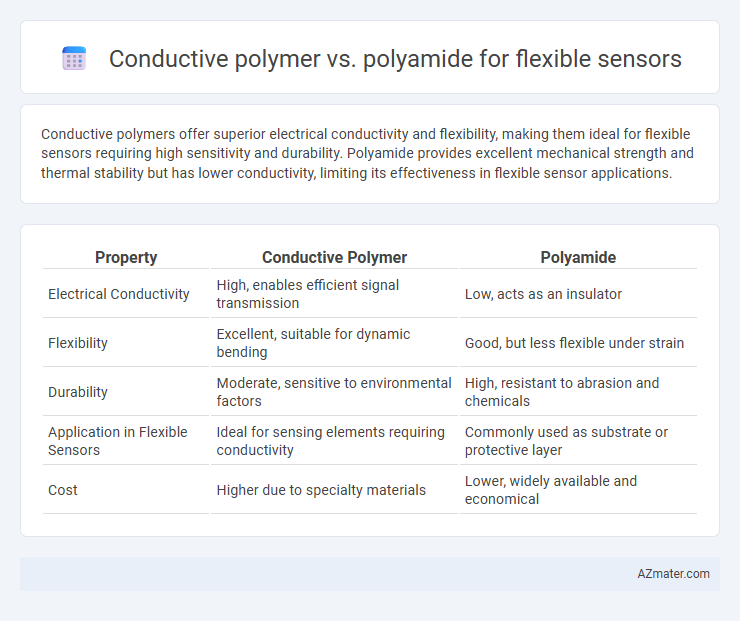Conductive polymers offer superior electrical conductivity and flexibility, making them ideal for flexible sensors requiring high sensitivity and durability. Polyamide provides excellent mechanical strength and thermal stability but has lower conductivity, limiting its effectiveness in flexible sensor applications.
Table of Comparison
| Property | Conductive Polymer | Polyamide |
|---|---|---|
| Electrical Conductivity | High, enables efficient signal transmission | Low, acts as an insulator |
| Flexibility | Excellent, suitable for dynamic bending | Good, but less flexible under strain |
| Durability | Moderate, sensitive to environmental factors | High, resistant to abrasion and chemicals |
| Application in Flexible Sensors | Ideal for sensing elements requiring conductivity | Commonly used as substrate or protective layer |
| Cost | Higher due to specialty materials | Lower, widely available and economical |
Introduction to Flexible Sensors
Flexible sensors rely on materials that combine mechanical flexibility with electrical conductivity to detect physical stimuli such as pressure, strain, or temperature. Conductive polymers like polyaniline and PEDOT:PSS offer excellent electrical conductivity and inherent flexibility, making them ideal for wearable and stretchable sensor applications. Polyamide, known for its mechanical strength and thermal stability, provides a robust substrate but lacks intrinsic conductivity, often requiring composite formation with conductive materials to achieve desired sensor performance.
Overview of Conductive Polymers
Conductive polymers, such as polyaniline, polypyrrole, and PEDOT:PSS, are widely utilized in flexible sensors due to their excellent electrical conductivity and mechanical flexibility. These organic polymers combine the benefits of metals and plastics, offering tunable conductivity, processability, and environmental stability. Unlike polyamides, which primarily serve as structural substrates, conductive polymers actively participate in sensing mechanisms by facilitating charge transport and signal transduction.
Understanding Polyamides in Sensor Applications
Polyamides exhibit excellent mechanical flexibility, chemical resistance, and thermal stability, making them ideal for flexible sensor substrates and encapsulation. Their intrinsic dielectric properties allow effective integration with conductive polymers, enhancing sensor sensitivity and durability in dynamic environments. Polyamides' biocompatibility and processability support advanced wearable and biomedical sensor applications, distinguishing them from purely conductive polymers.
Electrical Properties: Conductive Polymers vs Polyamides
Conductive polymers exhibit superior electrical conductivity compared to polyamides, making them highly suitable for flexible sensors requiring efficient signal transmission. Polyamides are inherently insulating with low electrical conductivity but offer excellent mechanical strength and flexibility, serving primarily as structural substrates in sensor applications. The integration of conductive polymers with polyamides can optimize sensor performance by combining electrical conductivity with mechanical robustness.
Mechanical Flexibility and Durability Comparison
Conductive polymers offer superior mechanical flexibility compared to polyamides due to their intrinsic elasticity and ability to maintain conductivity under repeated bending and stretching cycles. Polyamides provide excellent durability with high tensile strength and resistance to environmental factors but tend to be more rigid and less adaptable to continuous deformation in flexible sensors. The choice between conductive polymers and polyamides depends on the specific application requirements, balancing flexibility for sensor sensitivity and durability for long-term performance.
Sensitivity and Responsiveness in Flexible Sensors
Conductive polymers exhibit superior sensitivity in flexible sensors due to their intrinsic electrical conductivity and tunable molecular structure, enabling precise detection of small mechanical deformations. Polyamide-based sensors provide enhanced responsiveness through their excellent mechanical flexibility and durability, yet often require composite integration to match the conductivity levels of conductive polymers. Optimizing the balance between polymer conductivity and mechanical properties is crucial to achieving high-performance flexible sensors with rapid response times and reliable sensitivity.
Fabrication Processes and Material Compatibility
Conductive polymers, such as PEDOT:PSS, offer facile solution-processing and compatibility with roll-to-roll fabrication techniques, enabling low-cost and scalable production of flexible sensors. Polyamide substrates provide excellent mechanical strength and thermal stability but often require surface modification to enhance adhesion and compatibility with conductive polymer layers. Optimizing interfacial bonding through plasma treatment or coupling agents improves sensor performance by ensuring efficient charge transfer and mechanical durability in flexible applications.
Biocompatibility and Environmental Impact
Conductive polymers, such as polyaniline and PEDOT:PSS, exhibit superior biocompatibility compared to polyamides, making them ideal for flexible sensors in biomedical applications due to their non-toxic, skin-friendly properties. Polyamides, while mechanically robust and chemically stable, often lack biodegradability, leading to higher environmental impact during disposal compared to conductive polymers, which can be engineered for eco-friendly degradation. The choice between conductive polymers and polyamides hinges on balancing sensor performance with sustainability, where conductive polymers offer a greener alternative with enhanced compatibility for long-term skin contact.
Cost-Efficiency and Commercial Viability
Conductive polymers offer superior cost-efficiency for flexible sensors due to lower material expenses and simpler processing techniques compared to polyamides, which require more complex fabrication and higher raw material costs. Polyamides provide enhanced mechanical strength and thermal stability, benefiting high-performance applications but increasing overall production costs, limiting commercial viability in cost-sensitive markets. The balance between conductive polymers' affordability and polyamides' durability dictates their adoption, with conductive polymers dominating large-scale, cost-effective flexible sensor manufacturing.
Future Prospects: Choosing the Right Material for Flexible Sensors
Conductive polymers exhibit excellent electrical conductivity and mechanical flexibility, making them ideal for next-generation flexible sensors that require high sensitivity and rapid response times. Polyamides offer superior chemical resistance and mechanical strength, supporting durability and longevity in wearable and harsh environment sensors. Future trends emphasize integrating conductive polymers with polyamide substrates to combine their strengths, enabling highly robust, flexible sensors with enhanced performance and broader application scope.

Infographic: Conductive polymer vs Polyamide for Flexible sensor
 azmater.com
azmater.com